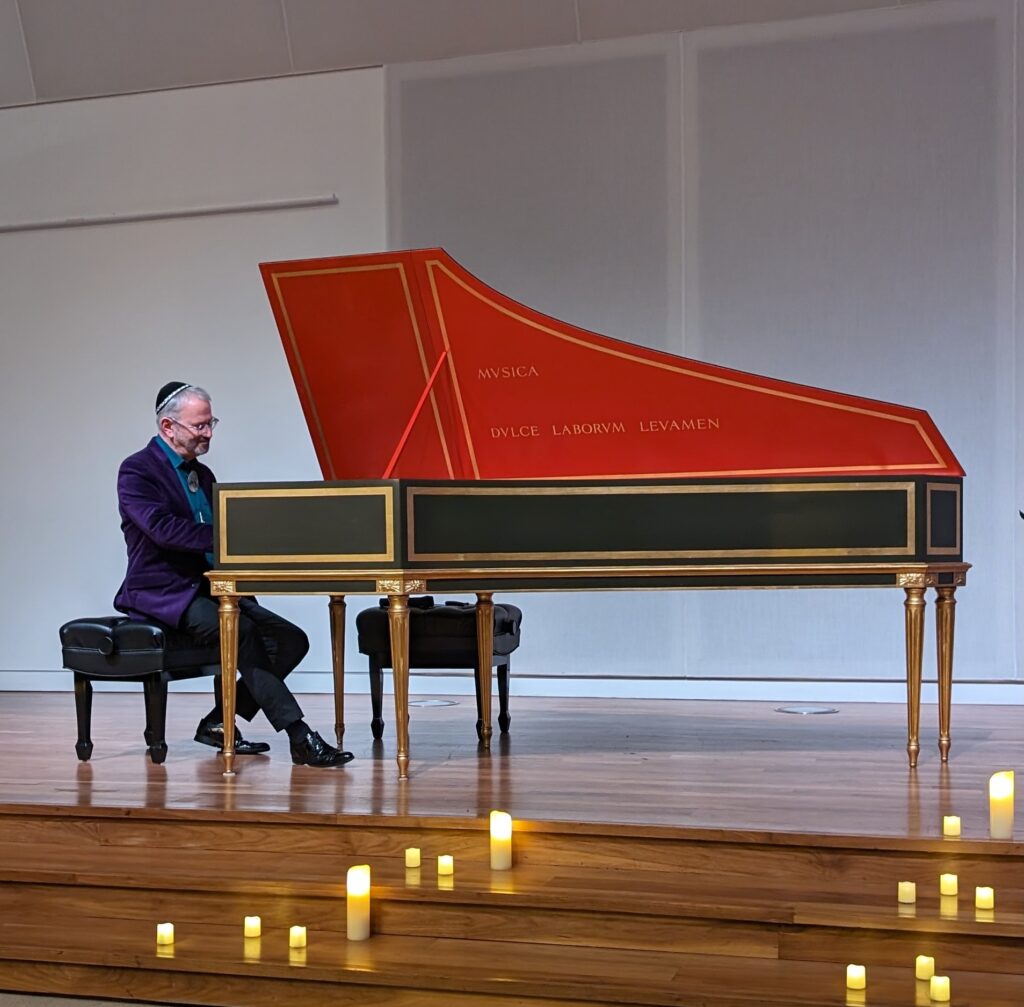Schenkman’s convivial debut provides a musical oasis with Capriccio Baroque

Byron Schenkman performed a recital for Capriccio Baroque Saturday night. Photo: C. Downey
Byron Schenkman explored the relatively late life of the harpsichord sonata in a wide-ranging recital Saturday evening. Presented by Capriccio Baroque in Live at 10th and G, the program centered on two sonatas by Joseph Haydn. The focus broadened with the inclusion of music by some of the Austrian composer’s contemporaries, both in his lifetime and slightly earlier.
Schenkman, co-founder of the Seattle Baroque Orchestra and faculty member at Seattle University, provided historical context in genial and succinct introductions. Haydn’s sonatas were likely played on both harpsichord and fortepiano, with the two options providing different strengths. Schenkman himself has recorded two discs of Haydn sonatas, made some twenty years ago, on a modern piano, which is a third option.
Haydn’s Sonata in F Major (H.XVI:23) opened the recital in a blaze of decorated motifs in the first movement. At the moment when the principal theme returned at the start of the recapitulation, Haydn wrote some flourishes for both hands in contrary motion. Schenkman, in a gesture repeated throughout the evening, added his own mini-cadenza at this point, putting an individual mark on the piece.
Schenkman chose a soft registration for the slow movement, further adding a charming ease of rubato to this Adagio in the parallel minor. The playful leaps of the third movement, taken at a rousing Presto, featured some athletic echo effects made by switching between the two manuals of the William Dowd harpsichord, owned by Capriccio director Carolyn Winter. Schenkman often omitted repeats, keeping the recital to about 80 minutes of music with no intermission.
Haydn’s Sonata in E Minor (H.XIV:34) offered a few more speed bumps in terms of the parallel thirds and sixths in the first movement. The long pauses, indicated by Haydn with fermatas, justified a more fluid, pleasing sense of rubato in this sonata, as well as another ornate cadenza at the return of the main theme. The Adagio movement, this time in the relative major, featured the evening’s only use of this harpsichord’s buff stop, a registration that offers a delicate sound like a lute or guitar.
In the third movement Haydn alternates between E minor and E major, a structural delineation that Schenkman emphasized by playing the latter sections on the softer manual. A few sticky moments came as Haydn ornamented the return of the main theme in more and more ornate ways, most notably with a challenging repeated-note motif near the end.
Schenkman juxtaposed these charming works with pieces by undervalued composers, starting with the Sonata in C Major (Op. 2, no. 4) by a woman named Anna Bon di Venezia. She was trained at the Ospedale della Pietà in Venice, not as an orphan but an admitted student, where she studied with musicians trained by Vivaldi. Her compositional technique included sparkling figuration in the fast outer movements, but the plangent middle movement proved the highlight for its harmonic variety, brought out expressively by Schenkman.
Another woman on the program, Marie-Emmanuelle Bayon from France, left just three keyboard works, including this Sonata in E-Flat Major (Op. 1, no. 3), full of active, inventive ideas reminiscent of Domenico Scarlatti. Schenkman played its two movements with bracing fingerwork.
Joseph Cologne, the biracial violinist known as the Chevalier de Saint-Georges, served as concertmaster for the premieres of Haydn’s symphonies in Paris, where he spent most of his career. Schenkman made the most of his Adagio in F Minor, likely an unrealized sketch that benefitted from some embellishment to fill it out in scope.
Three sonatas by Domenico Scarlatti provided greater musical diversion, with repeated-note displays and showy hand-crossings, after a false start to correct the registration setting on the harpsichord. This happened a couple times through the evening, due entirely to the unusual construction of this instrument, which William Dowd built for John Lewis, leader of the Modern Jazz Quartet, in 1972. Lewis, who was left-handed, asked for the registration stops to be reversed, which often trips up right-handed musicians.
Two encores, from earlier decades, seemed to suit the harpsichord even better, beginning with a Sarabande in G Major by Élisabeth Jacquet de La Guerre, lush with complex baroque harmonies. In a final gesture of peace and calm, to end a concert delayed by the presence of angry demonstrations downtown, Schenkman played a soothing, quiet Chaconne, arranged for harpsichord by d’Anglebert from the lute original by Ennemond Gautier.
Lillian Gordis plays harpsichord music by Byrd, Bull, Tisdall, and J.S. Bach 8 p.m. April 20. capricciobaroque.org
